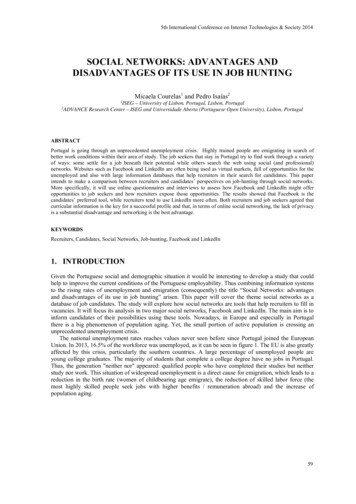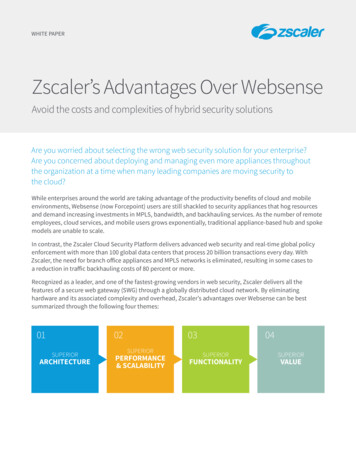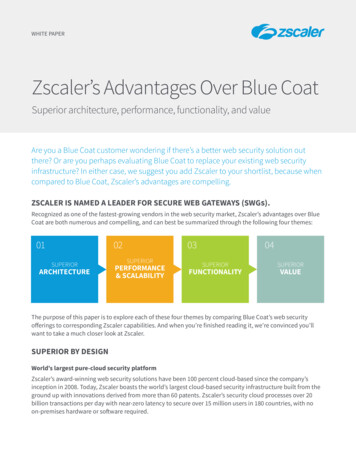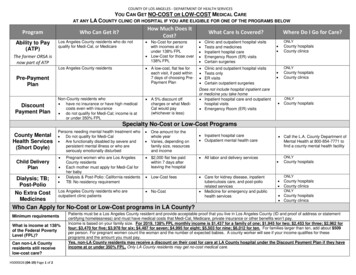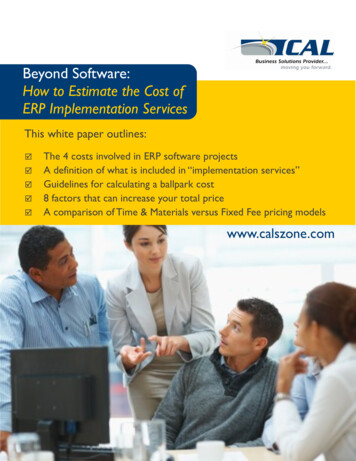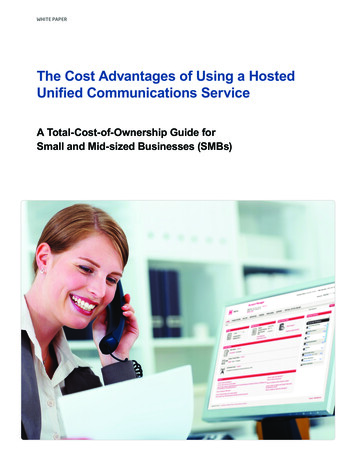
Transcription
White PaperThe Cost Advantages of Using a HostedUnified Communications ServiceA Total-Cost-of-Ownership Guide forSmall and Mid-sized Businesses (SMBs)
White PaperCost Advantages of a Hosted Unified Communications ServiceIntroduction: Making UC AffordableThe Web has empowered organizations large and small to collaborate and conduct commerce globally. As aresult, smaller businesses can compete with much larger organizations that might be located anywhere in theworld.A challenge for small and mid-sized businesses(SMBs), though, is finding the funding to scale theircommunications systems to rival the rich functionalityand flexibility that bigger competitors with dedicatedIT staffs deliver to their employees and customers.Budget restraints can make procurement of new onpremises IP telephony and unified communications(UC) solutions too expensive for many SMBs.Upfront capital costs are often prohibitive, as is therequirement for on-site staff resources to manage theUC equipment and application services.The traditional way of implementing enhanced IPtelephony features has been to install UC call serverequipment (sometimes called an IP PBX) on site andpurchase the software licenses and software updatesubscriptions needed to cover all the employees whowill be using the system. Upfront capital investmentscoupled with ongoing maintenance and softwarelicense management are unaffordable for manysmaller businesses, which are concerned primarilywith their core business, not telecommunications.Unified Communications DefinedUnified communications, or UC, is a bundle of integratedIP telephony-centric features and capabilities. Theseinclude basic Internet phone calling; traditionalenhanced phone features such as call conference,transfer and forward; and a mix of enhancedcommunications features and capabilities.Which enhanced communications features are availabledepends on the supplier, but they might include any orall of the following: Instant messaging (IM), or chat Presence (user availability) Fax over IP Web & Video conferencing Integrated inbox for emails, voicemails, missed callsand faxes Extension of some or all features to mobile devices Ability to make and receive office phone calls fromanywhere in the world with Internet connectivity.Basic and enhanced UC features alike lie atthe foundation of most businesses’ ability tointercommunicate and collaborate among employeesand to efficiently serve customers.This situation has driven interest in hosted UCservices – services that allow smaller organizationsto use an external service provider’s UC infrastructureand simply pay a monthly flat fee per user or an aggregate usage fee. Depending on the vendor and thebreadth of the service, hosted UC services might be referred to as “hosted/virtual PBX,” “hosted UC,”“communications as a service” (CaaS), “UC as a service” (UCaaS), or “cloud UC services.”Whatever the moniker, the setup allows SMBs to enjoy the economies of scale of very large organizations.Resources are shared among thousands of customers, which lowers the incremental amount paid by each.Among the resource costs that can be shared: telephony/UC call server equipment, real estate, power, security,software (including patching and updating), management and staff expertise.When using cloud UC services, SMBs offload the upfront capital expenditures associated with buying anIP PBX/call server and software licenses to the UC hosted service provider. They also avoid the cost oftechnology refreshes. Cloud solutions enable SMBs to get the features and capabilities they need over theInternet, rather than installing and maintaining their own UC infrastructure incurring greater real estate, energyand staffing costs.2
White PaperCost Advantages of a Hosted Unified Communications ServiceSmaller organizations like retailers, banks, healthcare clinics and school districts are focused on succeedingwith their primary business rather than telecommunications. Technical and operational aspects of today’sadvanced communications systems come with increased complexity and costs that often exceed an SMB’sexpertise and budget. (see Table 1).Table 1. What Do You Buy?When You Procure Your Own UC SystemWhen You Use a Hosted UC Cloud Service Handset for each employee Handset for each employee Power-over-Ethernet switches Power-over-Ethernet switches WAN router for each site (if not already in place) WAN router for each site (if not already in place) Internet service for each site (if not already in place) Internet service for each site (if not already in place) Gateways for PSTN connectivity Per-user one-time activation fee IP PBX/server Software Licensing fees Maintenance fees (average 18% of system costper year) Subscription fees for software updates Management and monitoring tools Vendor-specific training ( 1,000 to 5,000 per staffmember) Ongoing operational costs, internal and external(percentage of worker’s salary devoted to UC operations) Public telephone network long-distance services andlocal telephone (or SIP trunking) servicesSources: Nemertes Research, Joanie M. Wexler & AssociatesConsidering the TradeoffsThe on-premises solution has some advantages for larger organizations. It leaves security behind thebusiness’s own firewall and does not require an Internet connection for telephony if all users are local. But,remote workers would still need some network access to the technology to access the public switchedtelephone network (PSTN). And while the cloud service solution requires much less staff expertise and time,it does involve managing the vendor relationship with the provider. It also needs greater Internet bandwidthand relies on trusting the cloud provider with most security issues. The solutions are equal in the number ofphysical phones needed along with LAN and router requirements, as shown in Table 2.3
White PaperCost Advantages of a Hosted Unified Communications ServiceTable 2. UC: Owning vs. Hosting Cost/Complexity Comparison for SMBsConsiderationOn-Premises SystemUC Cloud ServiceWinnerReal Estate CostsSMB must provide rack spacefor UC call server and relatedequipmentNo real estate required exceptfor on-premises network routerHosted UC servicePower/Cooling CostsSMB pays monthly energy billCost included in service feeexcept for routerHosted UC servicePhone Costs (Capital)New IP phones and softphonelicenses might be requiredNew IP phones and softphonelicenses might be requiredEqualPSTN Connection andAdministration CostsProcured and managed by SMBstaffProcured and managed by UCproviderHosted UC serviceNetwork ConnectionsInternet connections for remoteteleworkers necessary whenIP phones or softphones aredeployed. PSTN lines (or SIPtrunks) still required to receivedial toneInternet connections for remoteteleworkers necessary whenIP phones or softphones aredeployed. PSTN dial toneprocurement bundled into theserviceHosted UC service (slight)Disaster RecoveryAt least two sites with UCequipment, power and coolingrequiredBuilt into the service. RequiredWAN connection to cloudcreates single-point-of-failure/possible reliability issueHosted UC service (slight)StaffingRequires IT staff familiar withUC vendor’s equipment toprocure, deploy, configure andmanage. Requires telecomexpert(s) to negotiate PSTNcontracts, manage carrier,handlemonthly billingRequires part-time liaisonto manage hosted providerrelationshipHosted UC serviceTechnology RefreshInstalled by customer and,depending on how oftentechnology is updated, requirestime, effort, and expense witheach upgradeHappens automatically, behindthe scenes, usually at no extracostHosted UC serviceSources: Delphi, Inc.; Joanie M. Wexler & AssociatesSmaller organizations focus budget dollars on resources and work processes that relate directly to their core businesses and less onon-site telecom staffing and solutions.Premises-based call server equipment often comes with features that users might not need but increase theprice. SMBs often overprovision software licenses and maintenance subscriptions to prepare for potentialgrowth, thus paying for more resources than are necessary. By contrast, cloud-based services usually can besubscribed to on a feature-by-feature basis, thereby avoiding a larger license fee for unused features and givingSMBs greater control over which features they offer to which users. Since SMBs usually subscribe to hostedservices on a per-user basis, they pay as they go, rather than purchasing unused capacity upfront.Flexibility is another consideration. Moves, adds and changes can be accomplished in a matter of minutes,versus days required to free up IT staff (if available on site) or to call in the UC vendor to help assist.Sample Pricing ComparisonComparing pricing can be difficult, because vendors price their UC features differently; some are included inbundles while others are sold a la carte. Below is a total cost of ownership comparison between ShoreTel’s lowpriced SMB UC on-premise offering and 8x8’s hosted UC solution.4
White PaperCost Advantages of a Hosted Unified Communications ServiceUse Case Assumptions: The sample comparison assumes 55 users distributed across three sites, with25 users located at two sites and 5 users at one site. Features include unlimited calling, all traditional basicand enhanced PBX telephony features (call waiting, call transfer, three-way call conferencing, caller ID, autoattendant, etc.), Internet faxing for 10 users, online conferencing for 10 users, call recording and presence(user availability).Table 3. Hosted Service Versus On-Premises Equipment: A Sample ComparisonUpfront Costs8x8 (hosted UC service)IP PBX (on-premises)Capital equipment, phones, activation fees,software/mobility licenses 7,824* 36,086**Training and installation0 22,169TOTAL Upfront Costs 7,824 58,255Carrier fees (including trunk charges and local/long-distance usage charges) 1,850(per formal 8x8 quote) 2,475 (estimating approximately 45 per user***x 55 users)Maintenance0 510 [18% of system cost per year ( 6,119) dividedby 12 months]External IP faxing (10 users)0 (included) 143 (eFax, list price)External Web conferencing (10 users)0 (included) 390 (Citrix GoToMeeting, list price withyearly discount)Mobile device support0 (included)Included in upfront license costsTOTAL Per Month Recurring Fees 1,850 3,518Total Year 1 30,024 [7,824 (1,850 x 12)] 100,471 [58,255 (3,518 x 12)]Total Year 2 (maintenance and service fees only) 22,200 42,216Total Year 3 (maintenance and service fees only) 22,200 42,216Total Year 4 22,200 42,216 Technology Refresh Expenses(Unknown)Monthly FeesYearly TotalsCost Savings with Hosted UC Service, Years 1 - 4 70,447 – Year 1 Savings [ 100,471 – 30,024] 20,016 – Year 2 Savings [ 42,216 – 22,200] 20,016 – Year 3 Savings [ 42,216 – 22,200] 20,016 – Year 4 Savings [ 42,216 – 22,200] 130,495 TOTAL COST SAVINGS over 4 years, not counting tech refresh Source: 8x8 Competitive Analysis*Includes 55 Polycom SoundPoint IP 550 phones and a one-time activation for each of 55 users. Does not includeshipping/handling/tax.**Uses discounted ShoreTel equipment pricing for IP PBX sample costs, because ShoreTel is known as a competitively pricedsolutions vendor. ShoreTel site configurations assumed are as follows:- Site 1 with 25 users: One ShoreTel Voice Switch T1K and one ShoreTel SG-30- Site 2 with 25 users: Two ShoreTel SG-120s and one SG-30- Site 3 with 5 users: One ShoreTel SG-90 (support for 4 analog trunks and additional 50 phones)- One ShoreTel Distributed Voice Server located at one site for backup telephony features and applications- 55 ShoreTel IP Phone 265s- Does not include shipping/handling/tax- Assumes typical ShoreTel discounting on based on deal size.*** T1/FT1/PRI/SIP trunking prices and calling plan prices will differ based on location and volume. A price of 45 per user is used in thissample to account for all trunking and local and long-distance usage charges at all three sites. For example, let’s assume a T1 trunkat each site. T1s vary widely in price from about 200 to 1,200, depending on location and contract. The average of the two is 700.If each of three sites had a 700 T1 trunk, total trunk charges would be 2,100. Those charges divided by 55 users is about 38 peruser. Local/long-distance charges of 7 per month per user on top of the trunk charges are used as a conservative estimate ofusage fees.5
White PaperCost Advantages of a Hosted Unified Communications ServiceHosted UC Provider ConsiderationsThe business case outlined makes a compelling argument for considering a hosted UC service. It’s importantto compare similar packages when evaluating different hosted UC providers.Feature SetsDifferent UC providers have different business models and different feature sets. SMBs might have to pay extrafor features from one provider that are included for free with another provider. If special services, such as IPfaxing and Web conferencing, aren’t offered from a UC provider, SMBs will have to purchase these servicesfrom a third party. In this case these services may not be as well integrated as if they were all purchased fromthe same vendor.On the other hand, SMBs might not need the extra features that come bundled for a premium in a vendor’sbase service. As shown in the Hosted service vs. On Premise equipment comparison, make sure to account forall cost components for the desired solution when conducting an evaluation.End-to-End ControlAnother consideration is how the service is built – whether the provider relies on one or more partners likeBroadsoft or Amazon.com to develop and deliver their UC services. When multiple providers are involved,application integration and support coordination can become problematic.8x8 develops and manages its own software and network infrastructure and doesn’t rely on any otherproviders to deliver services. 1The company has complete control over customers’ service experience andsystem uptime. If a problem should arise, there is a single point of contact with no finger-pointing betweenmultiple providers.Mobile SupportNot all providers offer support for mobile devices. If accessing UC services on Apple iOS and Google Androidplatforms is important, SMBs should make sure these platforms are supported and the cost. 8x8 includesmobile device support in its basic UC offering at no extra charge.SummaryOrganizations today are looking to streamline expenses and reduce complexity wherever possible. SMBshave limited budgets for dedicated telecommunications and IT staff and need to focus their resources on theirprimary business. The cost and complexity comparisons presented in this paper indicate that SMBs lookingto minimize telecommunications spending should consider a hosted UC service. This would enable SMBs tooffload significant upfront capital expenditures, and let the service provider worry about technology updates.Complexity carries a cost that is difficult to measure but generally translates into time. Calculating man-hourssaved by not having to procure, install, maintain, troubleshoot, and refresh equipment is one way to quantify thebenefits associated with selecting a hosted rather than a self-managed solution.When comparing UC hosting providers to premises-based vendors, SMBs should account for all the variables,including the features and capabilities needed. This will increase the accuracy of total cost of ownershipcomparisons.18x8 has spent more than 25 years developing its UC technology platform and holds 79 patents. 2012. The 8x8, Inc. logo is a registered trademark of 8x8, Inc. 8x8, Inc. is a publicly traded company. SALES470/112/510
Sample Pricing Comparison Comparing pricing can be difficult, because vendors price their UC features differently; some are included in bundles while others are sold a la carte. Below is a total cost of ownership comparison between ShoreTel’s low priced SMB UC on-pre



